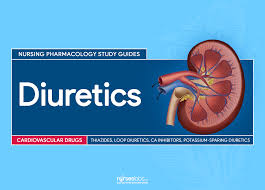Diuretics are drugs that increase the rate of urine outflow that result in removal of
sodium & H2o from the body which finally reduce the blood pressure.
They can be used as a monotherapy however they are widely combined with
other hypotensive drugs to enhance their effects by promote urinary outflow and reduce
plasma and extracellular fluid volumes.
Clinical indications:
In addition to hypertension they are effective in edematous states as abnormal
fluid retention, heart failure , hepatic ascites , portal hypertension , secondary
hyperaldosteronism & nephrotic syndrome
• Mechanism of action:
They are act to decrease re-absorption of sodium and enhance its excretion by
different ways according to the site on which they act. Excretion of sodium then
followed by water excretion result in an increase of urinary output (Diuresis) →
blood volume↓ and preload →
↓cardiac output → BP↓
Classifications ;
1Carbonic Anhydrase Inhibitors( CAIs). e.g; Acetazolamide used for glaucoma.
2- loop diuretics (potent diuretics) e.g; Furosemide, Torsemide,…
3-Thiazides ; e.g; Hydrochlorothiazid
4 -K+ Sparing diuretics; Triamterene, Spironolactone (used for
hyperaldosteronism & liver cirrhosis)
5-Osmotic Diuretics ↑water excretion by their osmotic pressure e,g; Mannitol
used for glaucoma

